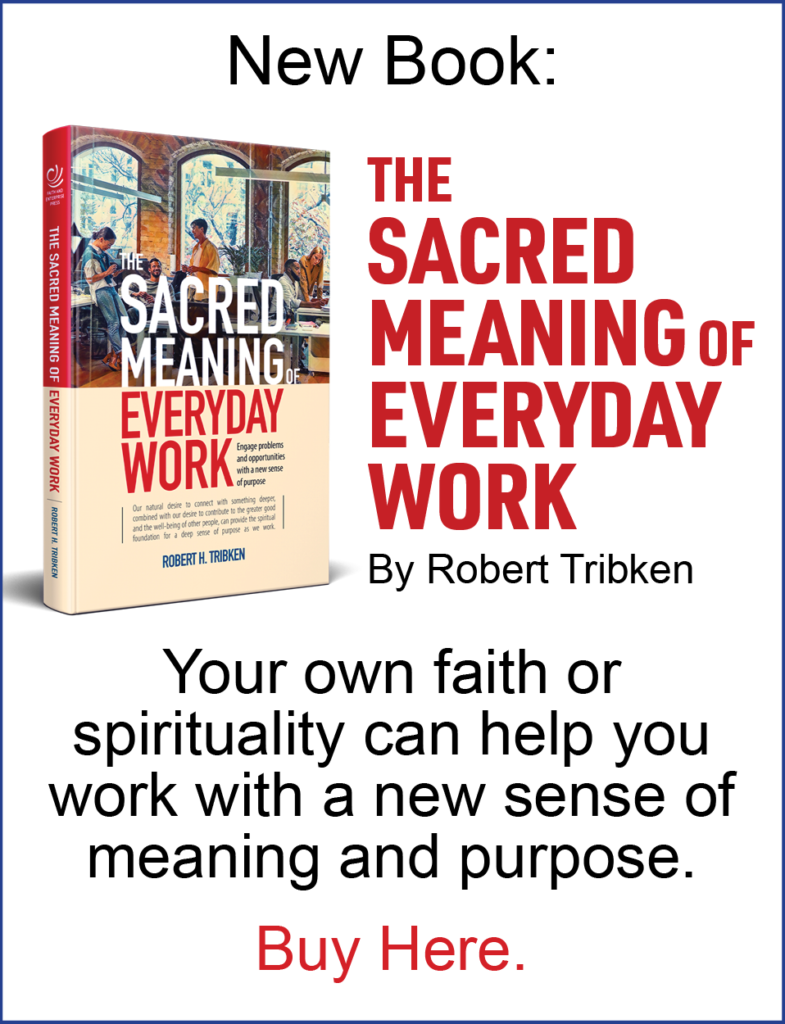Burnout as an Organizational, Psychological, and Spiritual Problem

By Rob Tribken
Chairman
Center of Faith and Enterprise
As you probably know, burnout is a big problem in the workplace. You might have experienced it yourself at some point, but in any case the chances are high that you know someone who is facing burnout right now. It’s a big problem, but there are things we can do about it.
I. What is Burnout?
Let’s begin by looking at what burnout actually is.
Psychologists Christina Maslach and Michael P. Leiter wrote a seminal book on the subject called the Truth About Burnout: How Organizations Cause Personal Stress and What to do About It. They talk about burnout like this:
What might happen if you begin to burnout? Actually, three things happen: you become chronically exhausted, you become cynical and detached from your work, and you feel increasingly ineffective on the job.(1)
Following Maslach and Leiter, there seem to be three key characteristics:
- Chronic exhaustion is the primary characteristic. This is not just the sort of tiredness we feel after working hard and for long hours over an extended period of time. This is chronic exhaustion – it stays with us, and always seems to be there. Our energy resources are depleted and we feel as though we just don’t have the energy to get the work done.
- There can be what some people call depersonalization, or maybe cynicism. Our work no longer seems to have meaning for us. And this can apply to our working relationships as well; we can feel detached or disconnected from the people with whom we work.
- We feel ineffective, and powerless, and this generally leads to reduced sense of accomplishment.
Burnout is in many ways the opposite of active engagement. Instead of feeling energetic, involved, and efficacious, we feel exhausted, uninvolved, and ineffective.
II. Causes of Burnout
Burnout results from prolonged and serious stress. The stress that leads to burnout usually results from the interaction between the individual and their work, or between the individual and their working environment. The dynamics can be quite complex; different individuals react to different stressors in different ways.(2)
One way to think about burnout is to consider it as the result of a long term mismatch between the individual and either the work or the working environment. This mismatch can take a number of different forms:
- There can be a mismatch between the requirements of the job and the skills and resources brought to the job by the individual. In some cases the individual might not have the skills necessary to do the work in a reasonably efficient and productive manner. Or, increasingly in today’s workplace, the individual might be overloaded — he or she might have more work than they can actually get done. In either case, the result can be a feeling of chronic overwork.
- The mismatch can involve our values. The work might seem to require the individual to do something that just does not sit well with them. Or it could be a situation where one feels like they are spending all of their time and energy on something that is quite different from what they believe is their true calling. This can lead to the individual asking the question “is this really what I am meant to do with my life?” and can be a very distressing situation.
- The mismatch can be interpersonal. For example, the individual might have trouble getting along with their boss or perhaps another coworker.
- A common form is when a person is working quite hard and believes they are performing well, but does not feel they are being compensated fairly, monetarily or in terms of respect and recognition. The feeling of being treated unfairly can be quite toxic, especially if it is allowed to continue over a significant period of time.
- A particularly troublesome situation can be one where the work puts high demands on the individual, but the individual is not given adequate control over how to meet these demands.
Each of these types of situations can create a great deal of stress that seems to grind us down until we burn out.
III. The Role of Passion
Quite often it seems as though the people who had been the most passionate about their work, and maybe had been the highest performers, are also the ones most subject to the risk of burnout. Psychologist Robert Vallerand has some important things to say about this. Vallerand has spent a great deal of time researching passion, including passion involving our work. He believes that there are two types of passion: harmonious passion and obsessive passion.
With harmonious passion, we can be passionate about our work, enjoy and place a high value on it, but when we stop working we can leave it behind and are free to turn our full attention toward something else. According to Vallerand:
“When harmonious passion is at play, individuals do not experience an uncontrollable urge to engage in the passionate activity, but rather freely choose to do so”.(3)
Harmonious passion is more likely to allow us to be fully absorbed in whatever activity towards which we have we turned our attention. Because of this, and because it does not eliminate other interests, harmonious passion tends to be life-giving and allows us to grow and develop.
Obsessive passion, on the other hand, can have a compulsive quality. We can feel obligated, maybe to meet the unfair expectations of others. Or maybe we are motivated to work very hard to protect our own sense of self worth in the face of challenges to our ego. The motivation for obsessive passion tends to be extrinsic – – such as when we are trying to protect our social status.
A key point is this: with harmonious passion, we control our passion. We can choose to engage in it or not, as we see fit. We can become absorbed in an activity of our choice. But with obsessive passion, the passion seems to control us. With obsessive passion it is difficult for us to leave the activity behind without continuing to think and ruminate about it; this prevents us from devoting our full attention to activities or interests apart from the subject of our passion. Paradoxically, with obsessive passion it can also be difficult to become fully absorbed in the activity about which we are passionate because we are concerned with extrinsic issues such as how others will view our work or whether the outcome will be positive or negative. As a result, obsessive passion is far more likely to lead to burnout.
IV. What Can be Done About Burnout?
Before proceeding, we should recognize that there are situations that are so toxic, so unfair that there is very little we can do without changing jobs. I think these are the exceptions, however; in most situations there are things that can be done to improve the situation.
A place to start is with organizational issues. If we are in a position to make changes to the organization, or perhaps to the way the workflow is organized, we can try to take action to try to remove the critical mismatches pertaining to the organization.
As an aside, if someone is in a position of leadership in the organization, it is important to be alert to the mismatches that can lead others into burnout – – and to take whatever action is availaable to fix them. This can be very important for the lives of the people involved. It can also be important for the effectiveness of the organization.
But what if one cannot change the organization or the objective nature of the work? What can we do as individuals?
First it is important to strengthen our psychological and emotional resilience. Physical health is important; adequate exercise, proper food, and getting enough sleep can help keep our mental and physical energy up. Strong, supportive interpersonal relationships are also important, whether they are within the workplace or without. These can help us build resilience and buffer us from some of some of the emotional effects of stress.
Leisure time is especially important. Stepping away from our work and leaving our work identity behind allows us time to recover from workplace stress, to be rejuvenated, and to reverse the depletion of our inner resources. There seems to be a sort of natural inner healing that takes place when we allow ourselves to be absorbed by an interest or an activity that is different from our work. Even a few minutes of rest and relaxation in the middle of the workday can be helpful, though we should not lose sight of the fact that we also need longer periods of time away.
But while leisure is important, the truth is that the very times when we are most in need of recovery also tend to be the times when it is most difficult to avail ourselves of the benefits of leisure. This can be either because we do not feel we can afford to take time off work, or because when we do take the time off we are too busy ruminating about our work to be able enjoy the time away. This is something at which many of us have to work; we need the recovery time, especially when we are facing burnout.
These points might sound obvious, and maybe they are, but we should keep in mind that when people are dealing with burnout, they are quite often in a sort of fog. They might be unable to see what would normally be the obvious opportunities for rejuvenation.
V. The Role of Faith and Spirituality
There can be an important role for our faith and spirituality, perhaps the central role.
Engaging in religious activities can, of course, be a way of getting away and recharging, much like our leisure activities. But our faith and our spirituality can also offer special resources and special benefits.
First, religious organizations such as churches can offer us a supportive community. The support we receive from others, whether in groups or in one to one conversations, can help us at several different levels, especially as our friendships deepen. Churches and other religious entities can be a good place to establish and develop these friendships.
Reading Scripture, exploring religious teachings, and engaging in personal reflection can all help us think about our work situation more productively. Doing so in a friendly community can be especially helpful; talking with others can help us develop and share new insights and maybe see the bigger picture more clearly. The right setting can also help us talk about and reflect on our work without falling into the trap of continuous rumination and self blame that can be so damaging.
Finally, and to my way of thinking most importantly, there are the spiritual or contemplative practices. Practices like prayer, meditation, worship, and the meditative reading of scripture can help us turn our attention towards God and strengthen our sense of connection. They can help us see the bigger picture and replenish our inner resources. Over time they can also help us work with a deeper sense of mission, purpose, and fulfillment.
There is something about turning our attention towards God in prayer and meditation that sometimes seems to connect us with something deeper than ourselves, and this can be a tremendous source of strength.
Of course none of these responses are likely to change the objective conditions under which we are working, but they can help us to deal with these objective conditions until we are in a position to change them.
Conclusion
It bears repeating that burnout is a very important problem both for us as individuals and for the effectiveness of our organizations. But there are things we can do about it. If we pay attention to the mismatches involving individuals and their work, and the attitudes and conditions under which we and our coworkers are working , we can be alert to the risk factors of burnout and then take steps to ameliorate them. This can be enormously important in the live of people who work, and it can also contribute to the effectiveness of our organizations.
References:
[1] Christina Maslach, Michael P. Leiter. The Truth About Burnout: How Organizations Cause Personal Stress and What to Do About It. (San Francisco: Jossey-Bass, 1997) Kindle Edition. Location 234.
[2] For a discussion of the dynamics of stress, see: Richard S. Lazarus and Susan Folkman. Stress, Appraisal, and Coping. (New York: Springer, 1984).
[3] Robert J. Vallerand. The Psychology of Passion: A Dualistic Model. (New York: Oxford University Press, 2015). Page 63.

